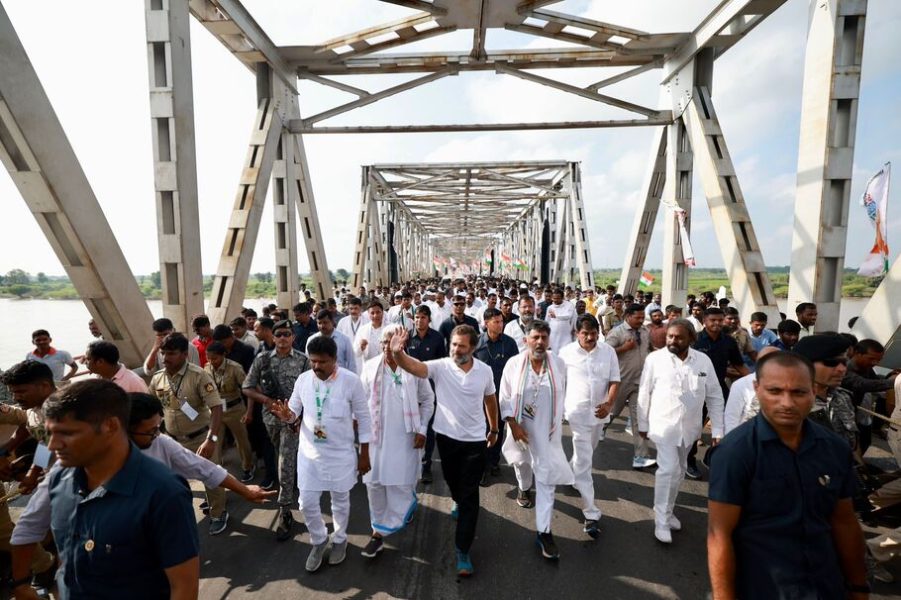
Bharat Jodo Yatra: Braving heat, terrain, Rahul on image makeover mission

The distance from Gundlupet in Chamarajanagar to Raichur district in Karnataka is almost 481 km. It will take Rahul Gandhi’s Bharat Jodo Yatra to nearly 1,150 km. However, that is not even half his targeted distance of 3,570 km from Kanyakumari to Kashmir.
Day by day, the tempo of Rahul’s Yatra is gaining momentum. And so is the temperature. The mercury is above 32 degrees Celsius in Raichur. Under the hot sun and the fast-flowing Tungabhadra river, the enthusiasm for the Yatra is also growing.
Most importantly, people are talking about Rahul and the Yatra—about his commitment, hard work, and his interest in public issues, including poverty, unemployment, and education. Also, they are happy about Rahul’s interaction with villagers and his interest in the facts. Their negative talk about him has turned positive. It seems Rahul’s image, as propagated by the Opposition, is changing.
Also read: Bharat Jodo Yatra: Rahul is walking into India’s hinterlands and hearts
Yes, he has made a few faux pas and faced some trolling. Even grassroots Congress workers suspect his leadership abilities. But the Bharat Jodo Yatra has given Rahul a much-needed makeover from a “childish” (thanks to the Opposition’s campaign) to a “matured” look.
“A mature politician who can face BJP”
The Federal followed the Bharat Jodo Yatra from Mantralaya (Andhra Pradesh border) to Raichur (Karnataka’s northern end) for about 25 km on Saturday. The overall feeling is that the Congress’s day is finally here, at least in Karnataka.
Several party workers said they were worried about the Congress’s lack of good leadership at the national level to face the BJP—particularly, Prime Minister Narendra Modi. They were even thinking of supporting the G-23 leaders and going against the Gandhis to save their party, which they have been supporting for years. But the Bharat Jodo Yatra has given Rahul the image of a more mature politician who can face the BJP, and party workers feel happy about this.
Also read: Bharat Jodo Yatra to enter Telangana on Oct 23
Fakeerappa Nayak, a party worker, said he was happy for Rahul and felt sorry about his negative thoughts about Rahul earlier. Bharat Yatri, who is part of the Bharat Jodo Yatra, claimed that Rahul was always a mature politician. Social media trolls gave him a “childish” image. He feels people are finally understanding what Rahul is capable of.
“We must keep up the tempo until polls”
KPCC president DK Shivakumar, who is a part of the Yatra, told The Federal that the BJP’s social media factory has created a negative image for Rahul. “But now, it is changing and people are understanding the reality. A tempo has been created among party workers, and we must keep it up till the next elections,” he said.
Saleem Ahmed, the working president of KPCC, said during the march that the Bharat Jodo Yatra was doing a tremendous job for the party, as it boosted party workers’ morale. Moreover, the image of Rahul Gandhi created by the BJP is slowly fading out. People are appreciating Rahul’s efforts on this massive march and his commitment towards the nations, and it has become an image makeover exercise at the right time.
Also read: Bharat Jodo Yatra: Key to Congress’ electoral revival lies elsewhere
The Bharat Jodo Yatra, which started from Mantralaya at 6 am with around 2,000 workers, ended at Yeragera village in Raichur, around 25 km away, with a crowd of around one lakh. It shows how Rahul’s march attracts party workers as well as common people. Educated classes, including doctors, lecturers, and others, joined the yatra, with common villagers making up the bulk. Other than that, party workers, seen joining the march from the nearby villagers, came as a relief for the Congress, as the party was accused of having “only leaders and no party workers.”
“We see a committed man”
Curious villagers told The Federal that they are seeing such as march for the first time. According to them, it did not look like a political procession, but that Rahul had “a commitment towards the nation.”
UT Khader, former minister and Deputy Leader of the Opposition in the Karnataka Assembly, felt happy that the party was gaining momentum at the right time because of Rahul. “Though Bharat Jodo yatra is an apolitical march to join the divided minds in the country, it helped the party gain its strength again,” he said.
Also read: Bharat Jodo Yatra: Mother, sister of Gauri Lankesh join Rahul in Karnataka
Many who took part in the march, including MLAs, MLCs, block and district INC committee members, workers, cadres, and support staff were astonished at Rahul’s energy. Many felt compelled to join Rahul after seeing him lead from the front. The strict routine he has followed during the walk—resuming the march after overnight rest—has motivated many. What surprised organisers was the lakhs of people from common walks of life participating in the journey on foot.
More marches planned
Meanwhile, the enthusiasm of party workers is growing, as they see Rahul working hard on this massive march. Whether the Bharat Jodo Yatra helps the Congress defeat BJP in the next elections or not, it has definitely helped change Rahul’s image and assemble party workers again.
Rahul’s initiative has prompted the Karnataka Congress to think of having a similar march before the 2023 Assembly elections. Shivakumar said the state unit will organize rallies in all 224 Assembly constituencies by two separate teams—one led by him and another by Opposition leader Siddaramaiah.
Also read: Bharat Jodo Yatra: Rahul pledges to ‘unite India’ in tribute to Gandhiji
Also, the party is planning to have a padayatra in Kalyana Karnataka, Kittur Karnataka, and Coastal Karnataka regions with the cause of providing water for agriculture from Mahadayi, upper Krishna Project, and communal harmony in the coastal districts.


